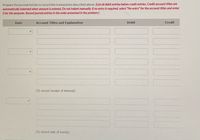
FINANCIAL ACCOUNTING
10th Edition
ISBN: 9781259964947
Author: Libby
Publisher: MCG
expand_more
expand_more
format_list_bulleted
Question
thumb_up100%
Please solve this accounting problem correctly. Fill out boxes the correct information

Transcribed Image Text:**Investment Scenario Analysis: Blossom Company's Bond Transactions**
**Overview:**
Blossom Company engaged in a financial transaction involving corporate bonds. On January 1, 2022, the company purchased 70 bonds from Rinehart Company. These bonds were characterized by the following features:
- **Interest Rate:** 5%
- **Maturity Duration:** 10 years
- **Face Value:** $1,000 per bond
- **Total Purchase Price:** $70,000
**Interest Details:**
The bonds provide annual interest payments, distributed every January 1st.
**Subsequent Transaction:**
On January 1, 2023, after receiving the annual interest payment, Blossom Company decided to sell a portion of its bond holdings. The company sold 40 out of the 70 bonds for a total of $37,800.
This scenario provides a practical example of bond investment, illustrating aspects such as initial purchase, interest payment, and the subsequent sale of securities.

Transcribed Image Text:**Journal Entry Form for Transaction Recording**
This template is used to prepare journal entries for recording financial transactions. Here is a detailed breakdown of the form fields:
---
**Instructions:**
- List all debit entries before credit entries.
- Credit account titles are automatically indented when the amount is entered. Do not indent manually.
- If no entry is required, select "No entry" for the account titles and enter 0 for the amounts.
- Record journal entries in the order presented in the problem.
---
### Form Fields:
**1. Date:**
- A dropdown menu to select the date of the transaction.
**2. Account Titles and Explanation:**
- A text field to enter the name of the account and a brief explanation of the transaction.
**3. Debit:**
- A field to enter the debit amount for the transaction.
**4. Credit:**
- A field to enter the credit amount for the transaction.
---
### Additional Guidance:
- **To record receipt of interest:**
- Utilize this line to indicate entries related to interest income.
- **To record sale of bonds:**
- Use this section for journal entries pertaining to bond sales.
---
This structured approach ensures clarity and accuracy in maintaining financial records, crucial for accounting purposes.
Expert Solution
This question has been solved!
Explore an expertly crafted, step-by-step solution for a thorough understanding of key concepts.
This is a popular solution
Trending nowThis is a popular solution!
Step by stepSolved in 2 steps with 1 images

Knowledge Booster
Learn more about
Need a deep-dive on the concept behind this application? Look no further. Learn more about this topic, accounting and related others by exploring similar questions and additional content below.Similar questions
arrow_back_ios
arrow_forward_ios
Recommended textbooks for you

 AccountingAccountingISBN:9781337272094Author:WARREN, Carl S., Reeve, James M., Duchac, Jonathan E.Publisher:Cengage Learning,
AccountingAccountingISBN:9781337272094Author:WARREN, Carl S., Reeve, James M., Duchac, Jonathan E.Publisher:Cengage Learning, Accounting Information SystemsAccountingISBN:9781337619202Author:Hall, James A.Publisher:Cengage Learning,
Accounting Information SystemsAccountingISBN:9781337619202Author:Hall, James A.Publisher:Cengage Learning, Horngren's Cost Accounting: A Managerial Emphasis...AccountingISBN:9780134475585Author:Srikant M. Datar, Madhav V. RajanPublisher:PEARSON
Horngren's Cost Accounting: A Managerial Emphasis...AccountingISBN:9780134475585Author:Srikant M. Datar, Madhav V. RajanPublisher:PEARSON Intermediate AccountingAccountingISBN:9781259722660Author:J. David Spiceland, Mark W. Nelson, Wayne M ThomasPublisher:McGraw-Hill Education
Intermediate AccountingAccountingISBN:9781259722660Author:J. David Spiceland, Mark W. Nelson, Wayne M ThomasPublisher:McGraw-Hill Education Financial and Managerial AccountingAccountingISBN:9781259726705Author:John J Wild, Ken W. Shaw, Barbara Chiappetta Fundamental Accounting PrinciplesPublisher:McGraw-Hill Education
Financial and Managerial AccountingAccountingISBN:9781259726705Author:John J Wild, Ken W. Shaw, Barbara Chiappetta Fundamental Accounting PrinciplesPublisher:McGraw-Hill Education


Accounting
Accounting
ISBN:9781337272094
Author:WARREN, Carl S., Reeve, James M., Duchac, Jonathan E.
Publisher:Cengage Learning,

Accounting Information Systems
Accounting
ISBN:9781337619202
Author:Hall, James A.
Publisher:Cengage Learning,

Horngren's Cost Accounting: A Managerial Emphasis...
Accounting
ISBN:9780134475585
Author:Srikant M. Datar, Madhav V. Rajan
Publisher:PEARSON

Intermediate Accounting
Accounting
ISBN:9781259722660
Author:J. David Spiceland, Mark W. Nelson, Wayne M Thomas
Publisher:McGraw-Hill Education

Financial and Managerial Accounting
Accounting
ISBN:9781259726705
Author:John J Wild, Ken W. Shaw, Barbara Chiappetta Fundamental Accounting Principles
Publisher:McGraw-Hill Education